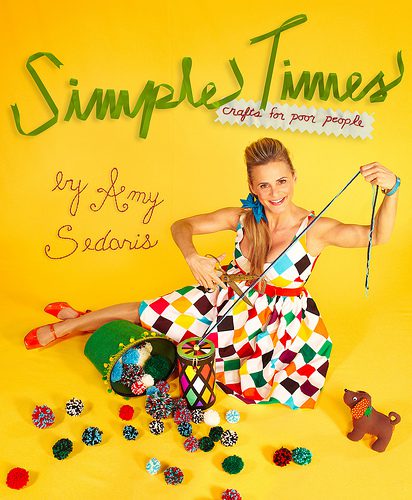
Feeling down? Make a Self-Esteem Shell Collage! Write a poem on a piece of paper about you and the ocean and about how you feel about the ocean and why you are special and of course the ocean and then surround the poem with whatever shells you collected that day so you will always remember it. The best time to hunt for shells is after a storm. Hopefully, those times will coincide with the times you are feeling down.
– Simple Times: Crafts for Poor People, by Amy Sedaris and co-written by Paul Dinello
I can never resist a Sedaris. Amy Sedaris’s new book, Simple Times, offers over three hundred pages of crafting projects, cooking recipes, and sexual positions. Sedaris will help you exercise your “imagination muscle” with projects including, “Killing Jar for Butterflies,” “Mouse Ghetto,” “Budget Tool Rack,” “Cut-Rate Sandwich Bag Condom,” “Distressing a Box,” “Fireside Hot Dogs on a Rake,” “Tampon Ghost,” and “Measure the Pleasure Tickle Rod.”
“It’s often been said that ugly people craft and attractive people have sex. This book is not going to dispel that ridiculous fact.” And it doesn’t. Rather, this book celebrates and illuminates the art of craft; as Sedaris explains, “Too often instruction for crafting is gutter-learned.” For those of you unfamiliar with crafting, Sedaris offers this definition: “Crafting, or ‘making things,’ has always been a delightful pastime of mine because it requires putting common elements together in order to achieve a lovely something that nobody needs.” Instructions range from impossible to obvious—from “self-explanatory” (i.e. “Tea Cozy Kitten”) to “cut a toilet paper tube into 3-inch rings. Cover the rings in lace or surgical gauze. Decorate the covered rings with ribbon or rickrack” (i.e. “Lacy Napkin Rings”).
Whether you’re crafting for money or crafting for Jesus, this book is for you. Buying Simple Times pays off with chapters like “The Joy of Poverty,” where Sedaris explains why her book is targeted toward the poor: “Even though we are amused by the abject poverty of our forebears, their spirit of making something out of nothing is one we should still embrace today.” Like when writing a book, “Being poor is a wonderful motivation to be creative, sort of a perennial carrot on a stick, but not an actual carrot because easy access to free food would only defeat the lucky stroke that is poverty.”
***
The Rumpus: Your new book Simple Times is a craft book for poor people, bipolar people, and everyone in between. What exactly is “decoupage”? If it is not already a sex act, how would you make it one?
Amy Sedaris: Decoupage of course is the art of decorating, or more accurately obscuring an object by gluing pieces of colored paper to it. I don’t know what you have been up to, but it is not a sex act. Although, most things can be turned into a sex act by adding massage oils, R&B music, and screaming.
Rumpus: This makes me think about the link between sensuality, creativity, and violence. In your section “Safety Meeting,” you say, “crafting mishaps range from paper cuts to murder.” You list among the Most Common Crafting Accidents “vaginal bleeding.” No question here; the purpose of this is to show your brilliance, hilarity, and sensitivity.
Rumpus: Is crafting like being vegan? If you do it, do you think you’re better than me?
Sedaris: I don’t think me being better than you is based on the fact that I craft, or whether or not I eat meat. I’m better than you because most of the questions I ask are not ridiculous.
Rumpus: I’ll take that burn because it’s coming from someone I admire. Like most people, whether they admit it or not, I crafturbate—either alone or in front of loved ones. How can we spread awareness that if one does it too much, one will not go deaf?
Sedaris: I’m sorry, I didn’t hear what you said. I lost the use of my ears mysteriously after a felting weekend. Well, that’s not completely true. I do still have some use, as my ears hold my glasses on my head.
Rumpus: A few weeks go I used arts and crafts to figure out my professional trajectory. I plotted out an entire book I will maybe write using only construction paper, colored markers, a wall, a hammer, and (what used to be) a picture of my ex-boyfriend. Do you agree crafting is the way to become a successful writer? If not, what is the way to become a successful writer?
Sedaris: The best way to become a successful writer is to either write about vampires, teenage witches or become Swedish and die tragically young after producing a series of crime novels.
Rumpus: That’s the answer I always get when I ask a professional how to become a writer. It’s making me mentally and physically unhinged, which leads me to your chapter “Handicraftable”; you point out, “There is absolutely no reason a handicapped crafter should abstain from crafting. The previous sentence is important so it shall be repeated. There is no reason, with the exception that the final results will range from inadequate to hilarious, that a handicapped crafter—socially, physically, or mentally—should abstain from crafting.” In your introduction to the book, you say, “Although this book is marketed toward sane, intelligent adults—frankly, that’s where the money is—should it fall into the hands of the mentally challenged, it will do them no harm.” Before I read the book, I worried, “Will it do harm to the emotionally damaged?” I found out the hard way, but I wanted your professional weigh-in.
Sedaris: That actually was a legal declaimer added to the book through the advice of my legal team. Truthfully this book will drive even the most grounded absolutely mad, or your money back.
Rumpus: In the “Making Love” chapter, an obvious chapter to have in a craft book, you write about “Fornicrafting,” a sacred and sometimes nauseating act between two or more crafters. You also discuss the importance of tools: “Most projects, in order to be successful, require the right tool for the job.” In a recent New Yorker piece, Malcolm Gladwell writes, “Where activists were once defined by their causes, they are now defined by their tools.” You go on to say in this chapter, “Sex toys, like all tools, allow us to be more efficient with less effort.” I further want to add this sentence you wrote, “You will find that working together, whether adding rickrack to pot holders or gluing eyes to coconuts, can be every bit as sensuous as helping your lover to an orgasm.” What would happen if you and Malcolm Gladwell got a craft room together?
Sedaris: First we would define each other with our tools, and then he would talk my ear off.
Rumpus: At least he got you off, part of you. While your book offers dubious craft advice, but great sex advice, I can’t help but focus on the section “Responsible for Your Own Orgasm.” You say, “An orgasm is much like the final available seat on the last lifeboat of a sinking ocean liner: everybody for themselves! Don’t expect an orgasm to be handed to you like a free cup of coffee. You must be aggressive in your pursuit, not unlike a raccoon foraging in a trashcan for any edible morsel. Having an orgasm is not a race, but still it’s important to win. Have you ever seen a track event? Take sprinters, for instance. The first racer across the line gets all the attention. Nobody is paying attention to the second-place finisher. When a couple is having sex, after the first orgasms occurs, you can pretty much count on 50% of the enthusiasm leaving the room.” No question; let’s let that sink in.
Rumpus [again]: Seriously, why does everyone love crafts in the likeness of owls?
Sedaris: Because we have been conditioned to believe that owls are wise, and by extension, we must be wise by having them in our home, therefore there must be another reason than stupidity for displaying this cheap, hastily created semi-likeness of an owl on our mantle.
Rumpus: Your section on “CUI: Crafting Under the Influence” is especially illuminating: “Pot addicts are likely to encounter the following two difficulties while crafting: 1. They won’t start a project and, 2. They won’t finish a project. That’s because marijuana is a liar. This ‘harby’ propagandist convinces those who ‘par-toke’ that ‘hanging out’ is ‘cool.’ Well it’s not cool! You know what else is not cool? The warm euphoria, the openness, and the easy flow of ideas that are the sinister realities this roadside weed deals in. For the reefer fiend, fancy becomes folly, tedious becomes thrilling, and the horrible becomes hilarious. Just imagine a dark world where people are in a perpetual state of peace and amusement.” No question here; I just miss San Francisco.
Rumpus [again]: What’s an example from your life where you used the healing power of crafting?
Sedaris: Once I used the beautiful medicinal qualities of crafting to help an old woman feel peace and security through tatting, shortly before she was forcefully euthanized.
Rumpus: This may be a personal question, but I’ll ask it anyway. In “Beautifying the Pleasure Patch,” what is your personal style: “The Sizzle Strip,” “Stalin’s Mustache,” “The Boll Weevil,” “The Muttonchop,” or “The Ole Granddad”?
Sedaris: These days, having a book out and making the rounds, I just don’t have the time to put into personal grooming so I just settled for the “Tumbleweed”—a mature and dry pubic mound which after a few months on the road disengages from the roots and tumbles away.
Rumpus: As someone who used to proofread cookbooks for a living until I got fired for not knowing how to cook or proofread, I appreciate you writing recipes that are fun and sometimes functional. Thank you, Amy Sedaris.





